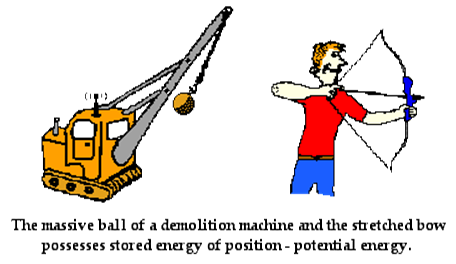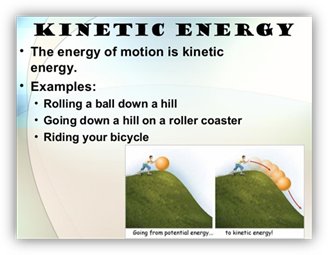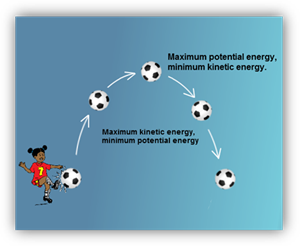POTENTIAL, KINETIC, MECHANICAL, AND
THERMAL ENERGY
Unit Overview
When you hear the word
“energy,” what comes to mind? Do you think of how much energy you currently
have? Do you think of electricity, or charging your devices? The term is used
in many different ways. What is energy, exactly? Energy is a measurement
of the ability of something to do work. It is not a substance, but it can be
stored, transferred, and transformed. There are different types of energy, and most
energy on Earth is derived from the sun’s nuclear reactions (radiant energy).
In this unit, you will investigate potential, kinetic, mechanical, and thermal energy.
Potential Energy
Potential energy is often thought of as energy of position or rest
energy. Potential energy exists because an object has potential to move. It is
often called gravitational potential energy because of its height above the
surface of the Earth. The higher an
object, the more energy it can gain as it falls towards the Earth. A book sitting on a table possesses potential
energy since it has the potential to fall off of the table. Why might the book
fall? There is a force pulling on the book known as gravity. The formula for potential energy is P.E. =
mgh (m = mass, g = gravity and h = height). Since gravity on earth is a
constant, there are two things that can increase potential energy: mass and
height. The height is measured from a reference point that is considered to be
at a point of zero energy. This point can change with the situation. It can be
the ground under your feet, the floor of the classroom, even the top of your
desk. A student on the 3rd floor of a building has more potential energy
compared to another student on the 2nd floor. A 200-gram weight sitting on a
table has more potential energy than a 100-gram weight on the same table.

To learn more about
potential energy, click on this link: http://www.physicsclassroom.com/class/energy/Lesson-1/Potential-Energy
Kinetic Energy
Kinetic energy is the energy of motion, or the energy of a moving
object. The amount of kinetic energy an object has depends on its mass and
velocity. As the kinetic energy of an object increases due to increased mass or
velocity, its potential energy decreases. This is because the energy, is no
longer being stored as potential energy but is rather used as kinetic energy. A
substance with a higher kinetic energy level will also have a higher
temperature. Likewise, as heat is added to a substance, the particles gain
energy and move faster, increasing kinetic energy.
The formula for kinetic
energy is K.E. = ½ mv2 (m = mass and v = velocity). By looking at the equation, you can see there
are two ways to increase kinetic energy, by changing the mass or changing the
velocity. For example, a cup of water
has a certain KE. To increase the KE you would need to add more water (mass) or
increase the speed of the molecules by adding heat. The following uses the formula in an everyday example. A small car traveling very fast will have the same kinetic energy as a large truck traveling slowly. The car has a
high velocity and a small mass, while the truck has low velocity and a large
mass, causing both moving objects to have the same kinetic energy.

The
image above shows examples of kinetic energy.

The
image above shows a simple example of the relationship between potential energy
and kinetic energy.
For more information on
kinetic energy, visit the following website:
http://www.physicsclassroom.com/class/energy/Lesson-1/Kinetic-Energy
Mechanical Energy
The sum of potential
energy and kinetic energy that an object possesses is called mechanical
energy. In other words, mechanical energy is an object’s energy due to
its motion and its position. The term “mechanical energy” is sometimes used
interchangeably with the term “energy,” describing an object’s ability to do
work.
For more information on
mechanical energy, read the following:
http://www.physicsclassroom.com/class/energy/Lesson-1/Mechanical-Energy
Thermal Energy
Thermal energy is the heat generated by movement of particles that
make up matter. There are many
applications of thermal energy beyond the way it will be discussed in this
unit. The mechanics problems using potential and kinetic energy typically
calculate to less than 100% efficiency, and this is because of the production
of thermal energy in the process. Thermal energy can result due to the forces
of friction and drag.
Read on to learn more
about thermal energy in the context of mechanics:
PhET
Simulation: Energy Skate Park Basics
Complete the PhET
Simulation below and answer question 9 through12.
Directions:
Click on “Intro.” When the intro opens, the U shape ramp will be selected; keep
it on this one. Click the check boxes to turn on the bar graph, grid, and
speed. Notice the toggle bar to change the mass of the skateboarder. Slide it
down to the “small” end. Click and drag the skateboarder to place him at the
beginning of the ramp, right next to the “6 meters” mark on the grid. The
skater will automatically start moving.
Quizlet Vocabulary
